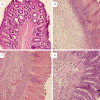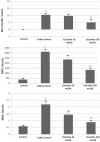Protective effects of citicoline on TNBS-induced experimental colitis in rats
- PMID: 24955172
- PMCID: PMC4057851
Protective effects of citicoline on TNBS-induced experimental colitis in rats
Abstract
The aim of this study was to investigate the effects of citicoline on the development of colitis and antioxidant parameters in rats subjected to tribenzene sulfonic acid (TNBS)-induced colitis. Twenty four Wistar Albino female rats were divided into four subgroups (n=6) (control, colitis control, colitis + 50 mg/kg citicoline, colitis + 250 mg/kg citicoline). Colitis was induced using an enema of TNBS and ethanol; following which citicoline was administrated for 3 days and effects of citicoline was subsequently evaluated. Based on microscopic damage scores, there was no difference between rats of the TNBS-colitis and 50 mg/kg citicoline treated groups, whereas treatment with 250 mg/kg citicoline, caused significant reduction in colon injury compared to that observed in rats of TNBS-colitis group. In terms of the biochemical analyses, myeloperoxidase (MPO), malondialdehyde (MDA), reduced glutathione (GSH), and IL-6 levels in rats from 250 mg/kg citicoline group were significantly different from that TNBS-colitis group. The levels of MPO, MDA, GSH and IL-6 in control rats were also significantly different those of rats in the TNBS-colitis group. Citicoline may have a positive protective effect on the inflammatory bowel disease treatment process and could, therefore, be used as an adjunct therapy in colitis. These effects of citicoline may exist through anti-inflammatory and antioxidant mechanism.
Keywords: TNBS; antioxidant system; citicoline; inflammatory bowel disease.
Figures



Similar articles
-
The effects of caffeic acid phenethyl ester (CAPE) on TNBS-induced colitis in ovariectomized rats.Dig Dis Sci. 2008 Jun;53(6):1609-17. doi: 10.1007/s10620-007-0056-2. Dig Dis Sci. 2008. PMID: 17957471
-
The effect of melatonin on TNBS-induced colitis.Dig Dis Sci. 2006 Sep;51(9):1538-45. doi: 10.1007/s10620-005-9047-3. Epub 2006 Aug 22. Dig Dis Sci. 2006. PMID: 16927145
-
Copaifera malmei Harms leaves infusion attenuates TNBS-ulcerative colitis through modulation of cytokines, oxidative stress and mucus in experimental rats.J Ethnopharmacol. 2021 Mar 1;267:113499. doi: 10.1016/j.jep.2020.113499. Epub 2020 Oct 19. J Ethnopharmacol. 2021. PMID: 33091486
-
Protective effect of naringin ameliorates TNBS-induced colitis in rats via improving antioxidant status and pro-inflammatory cytokines.Immunopharmacol Immunotoxicol. 2022 Jun;44(3):373-386. doi: 10.1080/08923973.2022.2049813. Epub 2022 Mar 10. Immunopharmacol Immunotoxicol. 2022. PMID: 35254187
-
Preclinical Study in Vivo for New Pharmacological Approaches in Inflammatory Bowel Disease: A Systematic Review of Chronic Model of TNBS-Induced Colitis.J Clin Med. 2019 Oct 1;8(10):1574. doi: 10.3390/jcm8101574. J Clin Med. 2019. PMID: 31581545 Free PMC article. Review.
Cited by
-
Ameliorative effect of citicoline on cyclophosphamide-induced lung injury.Open Vet J. 2025 May;15(5):2218-2229. doi: 10.5455/OVJ.2025.v15.i5.39. Epub 2025 May 31. Open Vet J. 2025. PMID: 40557095 Free PMC article.
-
Control of intestinal inflammation by glycosylation-dependent lectin-driven immunoregulatory circuits.Sci Adv. 2021 Jun 18;7(25):eabf8630. doi: 10.1126/sciadv.abf8630. Print 2021 Jun. Sci Adv. 2021. PMID: 34144987 Free PMC article.
-
The Attenuation of Scutellariae radix Extract on Oxidative Stress for Colon Injury in Lipopolysaccharide-induced RAW264.7 Cell and 2,4,6-trinitrobenzene Sulfonic Acid-induced Ulcerative Colitis Rats.Pharmacogn Mag. 2016 Apr-Jun;12(46):153-9. doi: 10.4103/0973-1296.177913. Pharmacogn Mag. 2016. PMID: 27076753 Free PMC article.
-
Red wine polyphenol extract efficiently protects intestinal epithelial cells from inflammation via opposite modulation of JAK/STAT and Nrf2 pathways.Toxicol Res (Camb). 2015 Oct 5;5(1):53-65. doi: 10.1039/c5tx00214a. eCollection 2016 Jan 1. Toxicol Res (Camb). 2015. PMID: 30090326 Free PMC article.
-
Postoperative serum metabolites of patients on a low carbohydrate ketogenic diet after pancreatectomy for pancreatobiliary cancer: a nontargeted metabolomics pilot study.Sci Rep. 2019 Nov 14;9(1):16820. doi: 10.1038/s41598-019-53287-y. Sci Rep. 2019. PMID: 31727967 Free PMC article.
References
-
- Loftus EV. Clinical epidemiology of inflammatory bower disease: incidence, prevalence, and environmental, influences. Gastroenterology. 2004;126:1504–1517. - PubMed
-
- Katz JA, Itoh J, Fiocchi C. Pathogenesis of inflammatory bowel disease. Curr Opin Gastroenterol. 1999;15:291–297. - PubMed
-
- Kucharzik T, Maaser C, Lügering A, Kagnoff M, Mayer L, Targan S, Domschke W. Recent understanding of IBD pathogenesis: implications for future therapies. Inflamm Bowel Dis. 2008;12:1068–1083. - PubMed
-
- Lih-Brody L, Powell SR, Collier KP, Reddy GM, Cerchia R, Kahn E, Weissman GS, Katz S, Floyd RA, McKinley MJ, Fisher SE, Mullin GE. Increased oxidative stress and decreased antioxidant defenses in mucosa of inflammatory bowel disease. Dig Dis Sci. 1996;41:2078–2086. - PubMed
-
- Kruidenier L, Kuiper I, Van Duijn W, Mieremet-Ooms MA, van Hogezand RA, Lamers CB, Verspaget HW. Imbalanced secondary mucosal antioxidant response in inflammatory bowel disease. J Pathol. 2003;201:17–27. - PubMed
LinkOut - more resources
Full Text Sources
Research Materials
Miscellaneous
